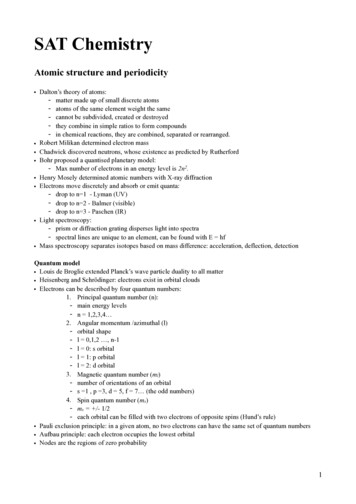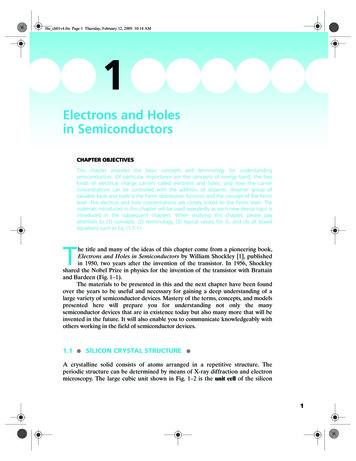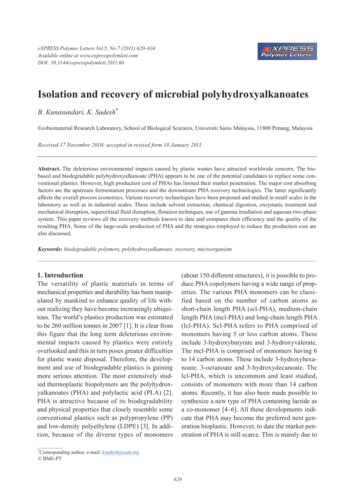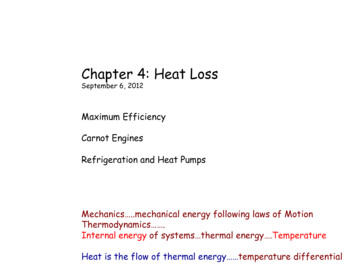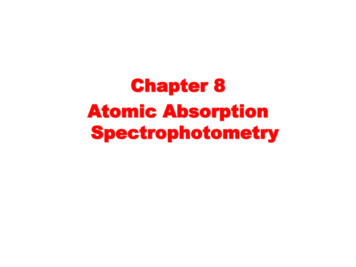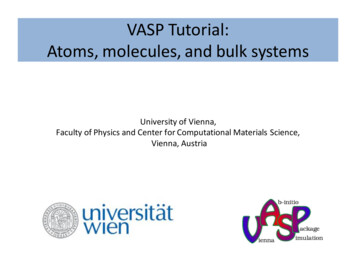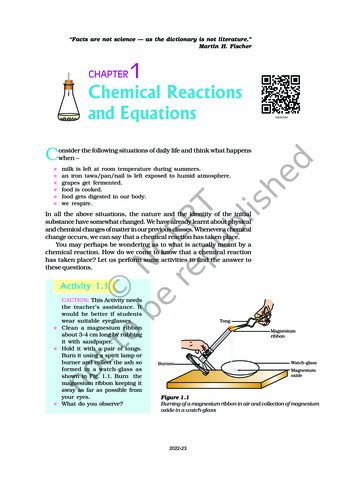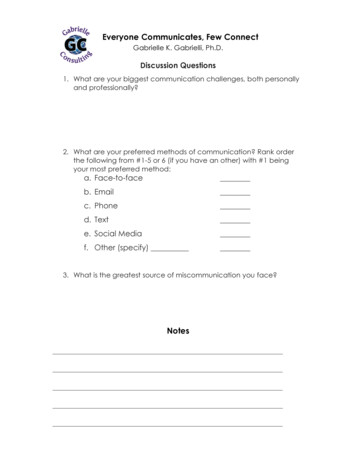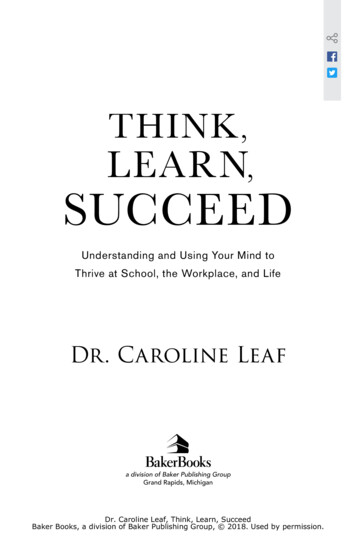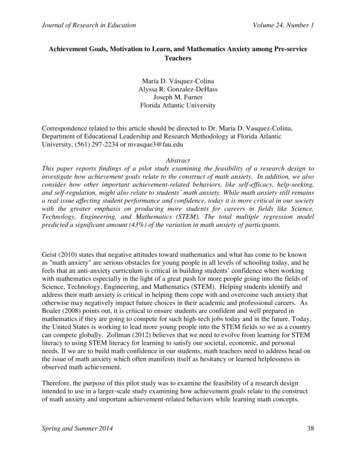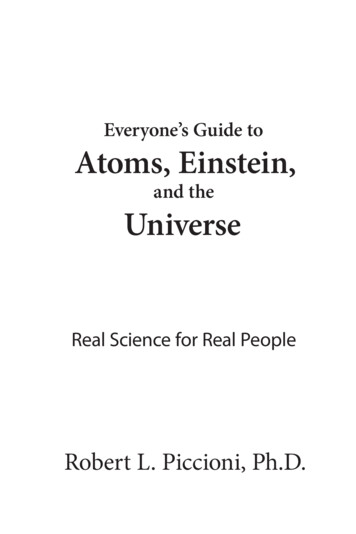
Transcription
Everyone’s Guide toAtoms, Einstein,and theUniverseReal Science for Real PeopleRobert L. Piccioni, Ph.D.
Real Science Publishing3949 Freshwind CircleWestlake Village, CA 91361, USAVisit our web site: www.guidetothecosmos.comCopyright 2009 by Robert L. Piccioni.All rights reserved, including the right ofreproduction in whole or in part, in any form.Cover and Interior Design by Fiona Raven: www.fionaraven.comEdited by Arlene Prunkl: www.penultimateword.comPrinted in Canada by Friesens Corporation: www.friesens.comisbn 13: 978-0-9822780-7-9First Printing June 2009
Contents1. Once Over LightlyPart 1 – The Micro-World2. Got Atoms?3. Einstein Who?Young AlbertCollege YearsMaleva MaricPatent ClerkThe Worst of TimesWas Physics Finished?4. Einstein Settles Atomic DebateBrownian MotionWhat is Science? What is Proof?Einstein Finds Solution5. Inside the Atom6. Elementary ParticlesParticles are Exactly IdenticalFermions: Constituents of MatterQuarksCharged LeptonsNeutrinosFirst-Generation Fermions RuleAre There More Particles?7. Antimatter8. Four Forces of NatureWhat is a Force?Bosons: Carriers of ForcesStrong ForceElectromagnetic ForceWeak ForceGravity1016202834384650
109. Energy, Mass, and E mc26010. Smart Energy66Fuel-Based EnergyRenewable Energy11. Particles and Waves74Photoelectric EffectParticle-Wave Duality12. Galileo and the Principle of Relativity82Are Relativity and Maxwell Compatible?13. Einstein’s Theory of Special Relativity90It's RelativeWhat Time Is It?SpacetimeSpace Travel and the Twin Paradox14. Einstein and Light100Light's Spectrum15. Al Makes Mom Proud104Can Physics be Beautiful?Einstein's Achievements16. Einstein and Quantum Mechanics108QuantizationSolving the "Ultraviolet Catastrophe"Particle-Wave DualityParticle Wavelengths Make Atoms StableWave PacketsQuantum UncertaintyThe Einstein-Bohr Debat17. Quantum Mechanics after Einstein120Quantum Mechanics Underlies Chemistry and BiologyQuantum Mechanics and ElectronicsQuantum Wave InterferenceSchroedinger's Cat Isn't CoherentThe Two-Slit ExperimentVirtual ParticlesIdentical Particle Effects
11Part 2 – Stars18. Twinkle, Twinkle Little Star A Star Is BornA long, Exquisitely Balanced LifeIs There Life After Hydrogen Fusion?Stars Die in a Blaze of GloryRising from the AshesWe Are 90% Star Dust19. Newton and Einstein on GravityGravity According to NewtonGravity According to EinsteinGravity Bends Starlight20. Einstein’s Theory of General RelativitySpacetime CurvatureEinstein's Field Equations21. Solving Einstein’s Field Equations22. General Relativity in ActionGravitational LensingPrecession of Planet MercuryGravitational Redshift23. White DwarfsType Ia SupernovaeDistance to SN1987a24. Neutron StarsPulsarsGravity Waves25. What Are Black Holes?Singularity and Planck LengthEvent Horizon and Escape VelcoityGravitational Tidal ForcesThe End of TimeGravity: Black Holes vs. a Star134144152162166170176182
1226. The Care and Feeding of Black HolesBlack Holes Can Become Super-MassiveAccretion Disks and JetsBlack Holes at Galaxy CentersSuper-Massive Black Hole in our GalaxyHawking Says Black Holes Evaporate27. nasa’s Great ObservatoriesPart 3 – The Universe28. How Much? How Large? How Old?Galaxies and their CollisionsThe Distant UniverseCounting StarsA Ruler to Measure the UniverseTime Scale of the UniverseTemperature Scale of the Universe29. What Is Our Universe?30. Telescopes Are Time Machines31. It’s the Same Everywhere32. Redshift / Blueshift33. ExpansionEinstein's "Greatest Blunder"Leavitt and Hubble Open the UniverseMeasuring the ExpansionWhat is Expanding?Expansion is AcceleratingWhat is Not Expanding?34. cmb: the First LightNobel or No BellCMB Informs CosmologyWe Live in the Golden Age of Cosomology192198204218222226230234246
1335. Dark MatterAre We Sure It Exists?Can it be Normal Matter We Can't See?OK, It's Something New. What Is It?Dark Matter Can't Clump36. Dark EnergyDark Energy from Virtual ParticlesThe Balance ShiftedIs Dark Energy the Cosmological Constant?37. Our Special Place in the Cosmos38. Can We Save Earth?Only Mankind Can Save EarthAsteroids and CometsIncineration by the Sun39. The Big BangEra of Quantum GravityEra of InflationFRW Expansion EquationEra of Big BangQuarks Cool Creating Nuclear ParticlesAntimatter VanishesSynthesis of Light NucleiFirst AtomsFirst StarsSun and Earth FormThat's Life!We Have Arrived40. What Came Before?Hawking: No "Before" BeforeThe MultiverseGuth: The Ultimate Free LunchLinde: Eternal InflationLQG: Collapse Before ExpansionSmolin: Cosmological Natural Selection254260264270274288
14Color Plates: 1 – 33BibliographyGlossary of TermsIndexTable of Redshift vs. TimeList of SymbolsSummary of Key PrinciplesMore Einstein QuotesList of SidebarsRefugees Help U.S. Fission while Fascists FizzleWhy Fund Science?No Nobel for RelativityFermi’s Delicious BookEinstein’s Expensive DivorceSilk Stockings Save DadFeynman at Los AlamosFeynman at CaltechShooting Pool with 269
15AcknowledgementsI applaud the organization and the people of nasa and its affiliatesfor their genius, diligence, perseverance, sacrifice, and achievement inimmeasurably advancing science and freely providing all their discoveries to the whole world. The lion’s share of all the spectacular celestialimages in this book come from nasa’s incomparable space telescopes—Hubble, Chandra, Spitzer, and wmap.I happily thank all the kind souls who assisted me.Bill Sampson meticulously scrutinized an early draft and vigorouslyhelped beat it into shape.Gray Jennings, Gene Burke, and Frank Geri kindly read the “finaldraft” and provided cogent ideas.Arlene Prunkl edited the text and put me in touch with the rightprofessionals to get the project completed.Brad Schmidt of Friesens went far beyond the call of duty to ensurethe finest reproduction of the photographs and images.Fiona Raven created both the cover design and the interior design.She patiently tutored me in the many facets of creating a book. Fionawas delightful to work with and an indispensable guide.My brother Richard Piccioni, Ph.D., a high school physics teacher,introduced me to the joy of speaking to a future generation of scientists,and provided many valuable suggestions.Most of all, I thank my wonderful wife Joan, who drained the Red Seamarking up countless, very rough drafts, and who kept our lives afloatwhile I obsessed over every detail. The credit for making the explanations of complex topics understandable belongs to Joan, who never letme get away with almost good enough.
1Once Over LightlyYou don’t need to be a great musician to appreciate great music. Nordo you need great math or physics expertise to appreciate the excitingdiscoveries and intriguing mysteries of our universe.We live in the Golden Age of Science. More has been discovered in thelast century than in all prior history. We are the first generation to haveseen almost to the edge of our universe and almost to the beginning oftime. We have seen the largest structures that exist in nature, and havediscovered its smallest parts. For the first time, physical science has acoherent story of almost everything.Our adventure begins by diving into the infinitesimal, then soaringthrough the stars, and ultimately reaching the limits of the universe.We will discuss almost all the major discoveries of modern physics,astronomy, and cosmology, and encounter several recurring themesalong the way: Everything is intimately connected, from the smallest to the largest,from atoms to people to the universe. Things that seem vastly different are often really the same. Einstein’s belief in the simplicity and beauty of nature inspired himto find unity and elegance in science. Great minds have extraordinary vision and often see what othersdo not. But sometimes they can’t see what others do.
1. Once Over Lightly17Part 1 examines our long journey to discover the micro-world—molecules, atoms, and everything smaller—and introduces those wholed the way.For 2500 years, some of the brightest minds struggled to discoverwhat everything we see is made of. In 1905, Einstein provided the criticalinsights that firmly established that matter is made of atoms. But atomsare not the end of this quest. Atoms are composed of electrons and nuclei.Nuclei are made of protons and neutrons that are themselves made ofquarks. Finally, we have reached the innermost layer of matter—twelveelementary particles. We have also discovered an unexpected bonus:antimatter.The interactions of these elementary particles underlie everythingin the universe through nature’s four forces: gravity, electromagnetism,strong, and weak. These forces light up the stars, create the atoms in ourbodies, enable all chemical and biological processes, preserve Earth’satmosphere, and shape planets, galaxies, and the universe itself.We will learn how an obscure clerk, rejected by the academic establishment, single-handedly shook the foundations of science and foreverchanged our understanding of energy, mass, light, space, and time.Einstein’s most famous equation E mc2 provides a deeper understanding of mass and energy that can lead us to develop dramaticallymore abundant and less polluting sources of energy. Future energyproduction can be a million times more efficient and less polluting thancurrent technology. Ultimately, by utilizing black holes, we may be ableto provide all the energy needs of a million people for 1 per day, anddo so with zero pollution.Einstein’s two theories of Relativity are among the crowning achievements of 20th century science. Building on the discoveries of Galileo,and extending the scope of Newton’s laws, Einstein opened the universeto science. He said that different clocks, even perfect clocks, keep timedifferently depending on their speed and location. There is not just oneright answer to the question, “What time is it?” Einstein explained whytime is relative, and why a jet looks shorter and heavier the faster it flies.Einstein’s theories constrain and enable distant space travel and alsoraise puzzling questions, such as the twin paradox.
18Everyone’s Guide to Atoms, Einstein, and the UniverseWe will examine the mysteries of Quantum Mechanics and its startling view of reality in the micro-world. We’ll also learn how QuantumMechanics made possible the electronic revolution that permeates ourlives through computers, cell phones, and all things digital. We will meetSchroedinger’s Cat and discover who had the last meow. Einstein madeseveral essential contributions to the development of Quantum Mechanics,including establishing the theoretical basis for the lasers that scan ourbar codes, read our CDs, print our documents, and sculpt our corneas.His contributions ultimately led to a quantum view of reality filled withuncertainty. However, Einstein himself never accepted the uncertaintyof Quantum Mechanics, declaring “God does not play with dice.”Part 2 explores how the micro-world impacts the macro-world (everything larger than molecules). In particular, the properties of particlescontrol the stars that have transformed the cosmos from a cold, empty,lifeless void to a universe of spectacular sights and endless possibilities.Stars both enable life and frame our future.We will follow the life cycle of stars: their birth, the exquisite balance of their prime, their rapid decline, and their ultimate deaths inimmensely violent explosions called supernovae. Through these explosive deaths, nature recycles vital resources, plants the seeds of rebirth,and leaves exotic remnants such as white dwarfs, neutron stars, andblack holes. With spectacular celestial photographs, we will examinethe bizarre nature of each of these exotic remnants, particularly themost enigmatic: black holes.Einstein’s Theory of General Relativity enables the Global PositioningSystem (gps). It also provides the foundation for our understanding ofstars, galaxies, and the universe. General Relativity is widely acceptedas the most beautiful theory in physics, and many believe it is the greatest achievement of human thought. Can a theory really be consideredbeautiful?We will examine nasa’s wonderful space telescopes, particularly theHubble Space Telescope, the greatest advance in astronomy since Galileo pointed the first telescope toward the heavens 400 years ago. nasa’sspace telescopes have opened up the heavens as never before.
1. Once Over Lightly19Part 3 builds on our knowledge of both the micro-world and themacro-world of stars to illuminate the mysteries of the universe. We beginwith an exploration of our universe as it is today. How big are galaxies?How many galaxies are in the universe? How large is the universe? Howsmall is its smallest part? Where do we fit into all this? What do we know,what don’t we know, and what might we never know?Next, we turn to cosmology and explore how the universe, and ourunderstanding of it, has evolved. Cosmology became a quantitativescience in the 20th century with Einstein’s Theory of General Relativity, the observations of Henrietta Leavitt and Edwin Hubble, and themeticulous study of starlight.Everything astronomers know about the cosmos comes from observing starlight. It’s amazing how much we can learn from the charmingtwinkle of stars. From the array of “colors” in starlight, astronomers canprecisely measure what stars are made of. From changes in these colorpatterns—redshifts and blueshifts—they measure the motions of starsand the universe.Leavitt discovered the key to measuring the distances to very remotestars. Hubble built on Leavitt’s discovery to demonstrate that there aregalaxies far beyond our own Milky Way. Then, Hubble used redshifts,as well as distances derived from Leavitt’s technique, to discover thatthe universe is expanding. We will learn the meaning of this expansion,what is expanding, and what is not.Some discoveries are the result of many years of careful preparationand precise observation. Others are fortuitous accidents, such as thedetection of the afterglow of the Big Bang. This accidental discovery,followed by decades of meticulous measurement, provides a grand storyabout the very early universe.Further, we will examine the special and wonderful place mankindoccupies in this vast universe, in a most favorable place, at a most favorable time, and enjoying a most fertile habitat.Next, we turn to cosmology’s greatest achievement, the Big BangTheory, starting with the beginning of space and time. We will examine the critical role played by the dark side of our universe: dark matterand dark energy.
20Everyone’s Guide to Atoms, Einstein, and the UniverseFinally, we will explore the most promising ideas about what camebefore the beginning and what lies beyond. While the rest of this bookis based on well-established science, this last discussion involves intriguing speculations.Our quest is similar to a grand buffet. Feel free to pick and choose. Ifyou don’t care for anchovies, don’t fret, just skip on to the next delight.If you don’t delight in Quantum Mechanics, simply move on to Stars. Tomake these cutting-edge concepts as accessible as possible, we translatephysics into English, replace equations by graphics, and provide a gallery of heavenly pictures.But the science is not “dumbed down.”This is real science for real people, like you.You will have much to think about.For your convenience, a Glossary of Terms, a List of Symbols, and aSummary of Key Principles of major physical theories are provided at theback of the book. You will sometimes see bracketed numbers such as [1]that indicate further discussion is in notes at the end of that chapter.I hope you enjoy and benefit from reading this book. If you have anycomments, suggestions, or questions, please contact me at:www.guidetothecosmos.com.Notes[1] For those not allergic to math, some more technical matters areexplored in notes at the end of chapters
PART 1The ntum Mechanics
19Newton and Einstein on GravityGravity appears to be the simplest of nature’s forces, perhaps because itis the most familiar. It may also seem incredibly weak compared withother forces because it is 1037 times weaker than the strong force. (Foran explanation of what 1037 is, see note [1] at the end of chapter 5.) Yetgravity is in many ways the most complex and the most powerful forceof nature. It controls the fate of the universe and everything in it.Galileo Galilei was the first to study gravity scientifically. He discovered that, ignoring air resistance, all bodies fall at the same rate—asimple but powerful law. Galileo also discovered the moons of Jupiter,the first objects ever seen that unquestionably orbit something otherthan Earth. Rather than burn at the stake for heresy, Galileo reluctantlyrecanted some of his discoveries.gravity according to NewtonSir Isaac Newton was the next to advance our understanding of gravity,publishing in 1687 his Principia Mathematica, thought by many to bethe most influential book in science. Newton was prolific as a physicist,mathematician, alchemist, and theologian. His other scientific discoveries include his laws of motion, the reflecting telescope, and the theory of
19. Newton and Einstein on Gravity23Figure 19.1. Newton understood why the Moon orbits Earth. At each moment,the Moon moves forward in the direction of its current velocity (dottedarrow) and it also falls toward Earth (solid arrow). The sum of these twomotions produces its orbital rotation around Earth.color. However, Newton is said to have spent more time on his unorthodox biblical interpretations than on science. As England’s Master of theMint for 28 years, he reformed the currency, routed out counterfeiters,and greatly increased England’s wealth and fiscal stability. For this, andnot for his outstanding contributions to science, Queen Ann knightedhim in 1705. A postmortem found very high levels of mercury in his body,no doubt due to his extensive work in alchemy. This could explain his“erratic” behavior in later life.Newton and Gottfried Wilhelm Leibniz independently invented anentirely new branch of mathematics: calculus. This enabled Newton toformulate physical laws by relating forces to small changes, and relating sequences of small changes to global motion. This was the dawn ofa new age of analytical science. Newton showed there is one law for allthings gravitational: a universal law of gravity that works for apples, theMoon, and everything else. Never before did science have such sweeping reach.
24Everyone’s Guide to Atoms, Einstein, and the UniverseLet’s explore how Newton explained our Moon’s orbit, as illustratedin figure 19.1. The dotted arrow indicates the Moon’s velocity at a particular moment. An object’s velocity is its speed and direction of motion,such as “60 mph due north.” If it maintains that velocity for 1 hour, itwill move 60 miles north. Maintaining that velocity for 1 minute movesit 1 mile north.A stable orbit requires a balance of gravity and velocity. Withoutgravity, the Moon would forever move in a straight line in the directionof its velocity. It would leave Earth and never look back. But because ofgravity, at every moment the Moon also falls toward the Earth, just asapples fall from trees, as indicated by the short solid arrow in the figure.If the Moon ever had zero velocity, it would begin falling straight towardEarth; its impact would vaporize our oceans and melt the planet’s surface.Fortunately, what actually happens is the sum of both arrows; the Moonfalls toward Earth and at the same time also moves forward with its current velocity. Each minute, the Moon moves forward 38 miles and drops16 feet toward Earth. A 16-foot drop seems tiny compared with 38 miles,but it’s exactly the right amount to turn the Moon from its straight linepath into its orbit around Earth. By staring at apples, Newton understoodthe motion of the Moon. (Ain’t physics cool.)Newton said that gravity is caused by mass and that only massresponds to gravity. Since we now know light is made of photons thathave zero mass, Newton’s laws say light is not affected by gravity. He alsosaid changes in the positions of massive objects are felt instantaneouslythroughout the universe. For example, if the Sun vanished, Earth wouldstop feeling its pull immediately. For that to be true, whatever “causes”gravity must travel with infinite velocity, which doesn’t seem reasonable. And by the way, what is it that actually “causes” gravity? What isthe mechanism by which the Sun reaches out and pulls on Earth across93 million miles of empty space? No one knew, not even Newton. Thismysterious, unseen mechanism is called an action-at-a-distance. Notunderstanding gravity’s mechanism bothered physicists, includingNewton. But since his laws explained what gravity did remarkably well,everyone just accepted them.Such were the laws of gravity for over 200 years.
19. Newton and Einstein on Gravity25gravity according to EinsteinEinstein changed everything. He said gravity is not a force after all, but isthe effect of the geometry of our universe being curved. If the geometryof the universe were Euclidean, rather than curved, there would be nogravity and all objects would move in straight lines. Earth orbits the Sun,Einstein said, because the Sun curves the geometry of the solar systemand Earth follows the straightest possible path in that curved geometry,as shown in figure 19.2.Figure 19.2. Einstein said that gravity is not a force but is the result of thecurvature of spacetime. The Sun curves the geometry of our solar system,somewhat like a bowling ball would deform a bed sheet. The Earth followsthe straightest possible path through this curved geometry—an orbitaround the Sun.Figure 19.2 shows only two dimensions of our universe’s four-dimensional spacetime. No one I know can draw, or even imagine, all fourdimensions at once; we can only draw part of the geometry and hopethat conveys the key ideas. In this figure, our universe is represented byonly the deformed two-dimensional surface with crisscrossed white lines.To make them easier to see, the Sun and Earth are shown as balls laying on that surface, but they should really be drawn as flat disks entirelywithin the two-dimensional surface of our universe. Anything outsidethis two-dimensional surface is outside our universe.
26Everyone’s Guide to Atoms, Einstein, and the UniversePerhaps our universe bends in a fifth dimension, corresponding tothe vertical direction of this figure. That larger space, with five or moredimensions, is called a hyperspace.Euclidean geometry is what we all learned in high school: parallellines never cross, and all that. All this is true on a flat surface, like asheet of paper, but it is not true on a curved surface, like the surface ofa sphere. For example, on Earth’s surface, the meridians are parallel atthe equator, but intersect at both poles. We’ll say more about curvedgeometries in the next chapter.Clearly Einstein’s concept is very different from Newton’s, as shownin figure 19.3. Einstein said that all forms of energy, not just mass, causegravity and that gravity affects all forms of energy, not just mass. SinceEinstein previously said mass and energy were equivalent, we should haveseen that coming. In Einstein’s gravity, there is no action-at-a-distance;the Sun curves geometry where it is, and Earth responds to the geometrywhere it is. Geometry is the mechanism that links the Sun and Earth;curving the geometry in one location affects the geometry everywhere(like pulling on one end of a bed sheet).Einstein said that changes in gravity are really changes in geometry.He called these changes gravity waves that ripple through space and timelike ripples on the surface of a pond, except that gravity waves travel atthe speed of light. If the Sun were to vanish, we would continue to see itslight and feel its gravity for another 500 seconds because that’s how longit takes light and gravity to travel 93 million miles. After 500 seconds,both the Sun’s light and its gravity would vanish together.Einstein also changed our entire understanding of space and time.Newton thought there could never be any disagreements about the lengthof a mile or the duration of a second because he believed space and timewere absolute and fixed—the same for every observer, everywhere andalways. He also believed space and time were two completely unrelatedentities. Einstein showed that space and time are relative—differentobservers measure different values for distance and time, and that spaceand time are intimately united as one entity: spacetime. They are reallytwo sides of the same coin. When one changes reference frames, someof what was space can become time and some of what was time can
19. Newton and Einstein on Gravity Gravity is a forceMechanism is unknownActs at a distanceMoves at infinite speedGravity is tied to massSpace and time- Two distinct entities- Absolute- Fixed 27Gravity is geometryMechanism is curvatureActs locallyMoves at light speedGravity is tied to energySpacetime- One united entity- Relative to observer- DynamicFigure 19.3. The two greatest physicists had very different theories ofgravity, as shown by this comparison. Left: Sir Isaac Newton (1642–1727)become space. In Einstein’s Theory of General Relativity, spacetime isdynamic—the geometry of spacetime is constantly changing as massand energy move.Newton viewed space and time as a fixed stage on which the drama ofthe universe is played out. Einstein viewed spacetime as a dynamic stagethat is part of the drama and that controls the motions of the actors.Einstein explained why, ignoring air resistance, all freely-movingobjects fall at the same rate, as Galileo had discovered. This is because allfreely-moving objects travel through the same curved, four-dimensionalgeometry, along the same curved paths—paths that have nothing to dowith their masses. In fact, light, which has zero mass, also moves alongthese same curved paths. Therefore, Einstein said, light bends as it passesa massive body like the Sun.
28Everyone’s Guide to Atoms, Einstein, and the Universegravity bends starlightAccording to Einstein, starlight passing just above the Sun’s surface bendsby 1/2000th of a degree. Light passing twice as far from the Sun’s centerbends half as much. Consider the situation shown in figure 19.4. Normally, the Sun is not in our line of sight to star A; then, light from thatstar is not bent by the Sun and we observe the star in its actual location.However, when the Sun moves into our line of sight, light from star Abends as it passes very close to the Sun. As we look back along the lightray that reaches us, the light appears to come from location A* insteadof location A. Therefore, we see star A appearing to be closer to star Bthan it actually is.When Einstein published General Relativity in 1915, the small bending angle he predicted could be measured (barely), but the challenge wasthat this measurement could only be done during a total solar eclipse.Stars near the Sun are visible only when the Moon blocks the Sun.Total solar eclipses are infrequent, brief, and localized. They occurabout once every 18 months, often in inaccessible places. Totality lastsonly a few minutes, and covers only a tiny sliver of Earth’s surface. Atany one location, a total solar eclipse occurs only once every 370 years.Astronomers have little chance to overcome error or bad luck—if the skyis cloudy, the opportunity to see stars near the Sun is lost.The solar eclipse of 1919 was centered in the South Atlantic. Britishastronomer Sir Arthur Eddington, shown in figure 19.5, made an extraordinary effort to get the most from this less than ideal opportunity to testEinstein’s revolutionary theory. Eddington, a Quaker and a conscientiousobjector, refused military conscription, which wasn’t well-accepted during the war. Only with the aid of powerful friends was he able to avoidprison and continue his research. Eddington led expeditions to bothsides of the South Atlantic, to Brazil and to the island of Principe nearAfrica. During the eclipse, his teams feverishly took picture after picture,through partially cloudy skies, hoping at least one would succeed.Standing under an immense portrait of Sir Isaac Newton, Eddingtonformally announced his findings at a meeting of Britain’s Royal Society.He declared that Einstein’s prediction of the bending of starlight was
19. Newton and Einstein on GravitySunMoon29AA*EarthBFigure 19.4. During a total solar eclipse, light from star A bends as it passesthe Sun. We see that light as coming from location A*—star A appears tobe closer than normal to star B, a star whose light is bent much less.Figure 19.5. Sir Arthur Eddington (1882–1944) and an image from the 1919solar eclipse. The indicated star's position confirms General Relativity.correct and that Newton’s theory of gravity must give way to GeneralRelativity. Again, a better understanding of gravity ushered in a newage of science.It is a tribute to international scientific cooperation that near the endof the catastrophe that was World War I, a British scientist devoted somuch effort to test a radical revision of Newton’s theory of gravity thatwas proposed by a German scientist.
Glossary of TermsAbell: catalog of galaxy clusters by George Abellabsolute zero: the coldest possible temperature, 0 Kelvin or 0 K (–460 oF),at which there is no heat and all atomic motion stopsacceleration: a, the rate of change of velocity; a car going from 0 to 60mph in 6 seconds has a 10 mph/secondaccretion disk: a cloud of material swirling around a massive body, suchas a black holeaction-at-a-distance: the purported ability of one object to affect anotherwithout direct contact, now discreditedamplitude: half the difference between a wave’s maximum and minimum valuesannihilate: to destroy completely leaving no material residue; antimatterand m
Einstein’s most famous equation E mc2 provides a deeper under-standing of mass and energy that can lead us to develop dramatically more abundant and less polluting sources of energy. Future energy production can be a million times more efficient and less polluting than current technol
